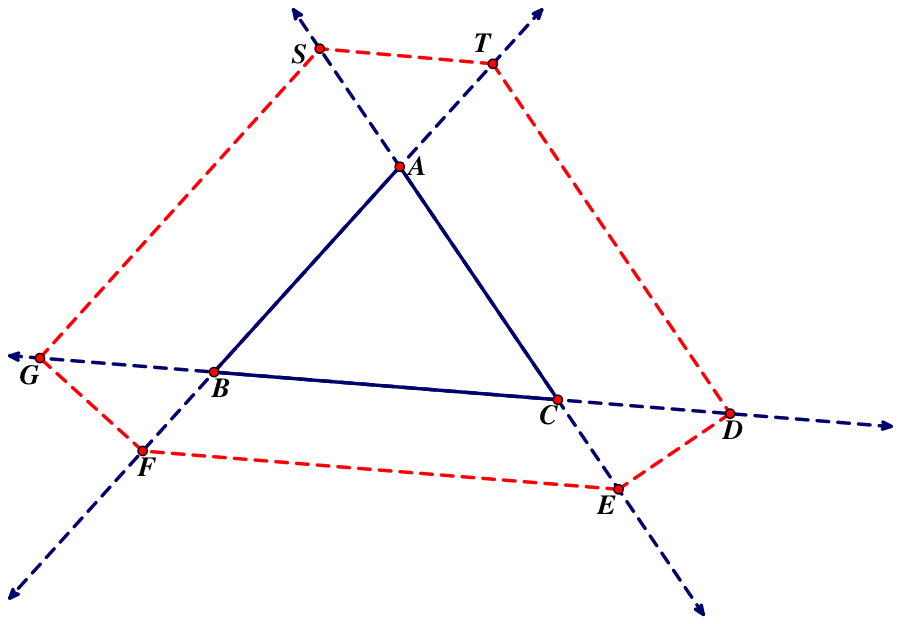

Final Project
Elizabeth Nelli
Bouncing Barney
Does the path create similar triangles?
3 of the 4 triangles are congruent and the fourth is similar. This fourth triangle is larger in size and “flipped” upside down based on its angles. So basically all the four angles are congruent when measuring their angles, but they are not congruent based on their side lengths.

Will he always return to the same starting point? Where does his starting point create congruent triangles?
When he starts 1/3 of the way on side BC, Barney’s path will create 3 congruent triangles.

Triangle ABC is made up of smaller triangles. Because of the properties of parallel and transversal lines, we get that ![]()
Using this triangle, I can figure out the angles of the remaining triangles to get:

When using the sketch of Bouncing Barney and using the formula from above, we can conclude that when Barney starts inside the triangle, he will always end up at the same place. Using measurement tools in GSP, I found that regardless of where Barney's starting point on BC is, he will always travel the same distance to return to his original spot. While the distances before he reaches a wall are not fixed, the total distance Barney travels is constant.
What if the starting point was at the centroid?
If he begins at the centroid, he will make only one triangle path before he returns to his starting point S. This makes sense because the centroid is the center of the triangle. This also makes sense that he will make only one more triangle because if he starts at the center, he will have to change directions each time he hits a wall (side of the triangle), which in this case would be twice because Barney will never reach side BC.

What if Barney’s starting point was at the orthocenter?
Again, Barney will make a path of 3 congruent triangles and 1 similar triangle in the middle that has the same angle measures with different side lengths that returns to his starting point.

When Barney starts outside of the triangle?
We have to extend the sides of the triangle so that Barney can "bounce" off the walls and switch directs. As you can see, he still will end up at his starting spot, S. He is walking parallel to AB, hits the wall at G, and starts walking parallel to AC. He then hits the wall at F and starts walking parallel to BC. He hits the wall at E and starts walking parallel to AB again. He hits the wall at D and walks parallel to AC again. He hits the wall at T and returns to S, walking parallel to BC.

Assignment 12: Stamps

| Year | Rate (in cents) |
| 1919 | 2 |
| 1932 | 3 |
| 1958 | 4 |
| 1963 | 5 |
| 1968 | 6 |
| 1971 | 8 |
| 1974 | 10 |
| 1975 | 13 |
| 1978 | 15 |
| 1981 | 20 |
| 1985 | 22 |
| 1988 | 25 |
| 1991 | 29 |
| 1994 | 32 |
| 1997 | 33 |
| 1999 | 34 |
| 2002 | 37 |
| 2004 | 39 |
| 2006 | 41 |
| 2008 | 42 |
| Year | Rate (in cents) |
| 1919 | 2 |
| 1932 | 3 |
| 1958 | 4 |
| 1963 | 5 |
| 1968 | 6 |
| 1971 | 8 |
| 1974 | 10 |
| 1975 | 13 |
| 1978 | 15 |
| 1981 | 20 |
| 1985 | 22 |
| 1988 | 25 |
| 1991 | 29 |
| 1994 | 32 |
| 1997 | 33 |
| 1999 | 34 |
| 2002 | 37 |
| 2004 | 39 |
| 2006 | 41 |
| 2008 | 42 |
| 2059 | 64 |
| 2127 | 100 |
| 3000 | 566 |